By LISA EISENHAUER
While scattered districts across the country that reopened for in-person classes have seen immediate outbreaks of COVID-19, some school-based health care workers say they are confident schools can operate without jeopardizing the health of students and staff in communities where the rate of the virus is low and strict precautions are observed.
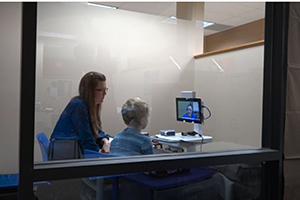
In this pre-pandemic telehealth visit, Avera eCARE School Health nurse Amanda Allison instructs a student at Deubrook Elementary School in Toronto, South Dakota, who is learning to manage his diabetes. The student is accompanied by a school secretary. Allison works from a telehealth hub about 80 miles away in Sioux Falls, South Dakota.
"I do still believe this can go smoothly," says Carol Hirchak, a nurse practitioner at a school-based clinic in Pineville, Louisiana. "I am not saying we will not have a student with COVID, but if everyone — students, parents, teachers, staff and the community — will follow the guidelines to mitigate this virus, it will go smoother."
Hirchak's clinic is part of the CHRISTUS St. Frances Cabrini Health System, based in Alexandria, Louisiana, and provides primary care at an elementary and a junior high with about 1,300 students in central Louisiana, a state hit hard by the pandemic. In the first few days of classes, in mid-August, Hirchak says students — even the ones as young as 4 — were following those guidelines to wear masks, stay 6 feet apart and wash their hands frequently.
Teachers were taking temperatures of students as they entered their homerooms and health workers at the schools had a stockpile of protective equipment, such as gloves and face shields. Anyone who had symptoms or felt sick was being sent home, advised to contact their health provider, and if they had a known exposure to someone with the virus, to quarantine for 14 days. Several days into their reopening, Hirchak was unaware of any cases of COVID-19 at any of the Louisiana schools covered by CHRISTUS's 17 clinics.
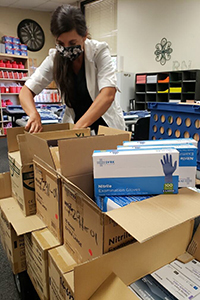
Christy Barton inspects boxes of supplies at the Rapides Parish School District offices. She is one of the 23 registered nurses who works for the public school system in central Lousiana. The district stocked up on supplies including gloves, face shields and hand sanitizer for all staff before students returned to classrooms in mid-August.
The Louisiana Department of Health reported that more than 134,000 people in the state were confirmed to have had the illness by mid-August and more than 4,200 had died. The department issued guidelines for school openings but was allowing individual districts to decide whether to restart in-person or continue virtual classes.
Based on news reports from across the country, some of the schools that had reopened by mid-August had quickly had to deal with outbreaks of the coronavirus that causes COVID-19. In Cherokee County in Georgia, more than 1,100 people were put in quarantine because of a school outbreak just days after students returned.
Urging in-person learning
Hirchak's confidence in the ability of schools to operate safely before there is a vaccine for COVID-19 is shared by some other school-based health care providers affiliated with Catholic health systems. Their faith hinges on schools following guidelines recommended by the Centers for Disease Control and Prevention and the American Academy of Pediatrics, both of which have come out in favor of having students physically present in school when local school officials say it is safe to do so.
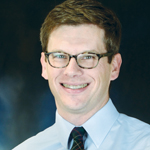
Bolton
Dr. Michael Bolton, a pediatric infectious disease doctor with Franciscan Missionaries of Our Lady Health System, has been relying on the CDC's and pediatrics' group's guidelines as he advises the clinicians and educators who are part of Health Centers in Schools, a program that provides health care for about 40,000 students in 75 schools in and around Baton Rouge, Louisiana. The Health Centers in Schools program is operated by Franciscan Missionaries of Our Lady subsidiary Our Lady of the Lake Children's Health.
Bolton agrees that in-person learning is best for students, especially the youngest ones. He also thinks that even though cases of COVID-19 are certain to crop up in schools, students can safely return to the classroom provided the schools are in communities with a low rate of new cases.
Bolton and other infectious disease experts have suggested safeguards for Louisiana schools that include:
- Arranging classrooms to maximize the distance between desks.
- Creating static groups of students and teachers who stay together throughout the school day to minimize comingling.
- Ensuring that the use of high-touch areas is minimized, such as by keeping often-used doors open.
- Offering as much instruction as possible outside, where masks can generally be shed without fear of contagion.
The fact that the safeguards seemed to be working well at a charter school that brought students back to campus in July was giving Bolton and others hope. The school is the focus of a pilot program in partnership with Health Centers in Schools that involves saliva testing of all students and staff for COVID-19 twice a week.
A new normal
Unlike those in Pineville, most schools in and around Baton Rouge were sticking with virtual-only classes through at least Labor Day. Officials cited high local and state rates of COVID-19 for their decision.
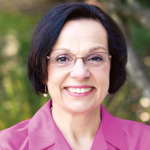
Combe
Laurie Combe, president of the National Association of School Nurses, says that while her group supports the idea that in-person learning is best for students, its top priority is the safety of students and school staff. The nurses association is urging that all districts have access to sound public health data on the rate of new infections on which to base their reopening decisions. The group posted several resources for nurses and school administrators on its website.
The group is also asking the federal government to provide at least $208 billion in funding for schools for a variety of needs, such as to stock personal protective equipment for health workers, to make facility upgrades such as ventilation improvements, and to set up isolation rooms for students who show signs of the infection until they can be assessed and, if needed, sent home. A survey the association did of its members found that before schools were closed because of the pandemic only 28% stocked N95 masks, which are recommended for use by medical workers, and only 23% had isolation rooms.
The federal funding the nurses group is seeking could also be used to hire health professionals for the 25% of schools that don't have one now or to increase access to mental health services. "What we've asked for is that school districts have maximum flexibility in understanding what their school community needs," Combe says.
Remote assistance
Sheila Freed, who directs the Avera eCARE School Health service line, says longtime school nurses like herself know that mental issues are a big factor in students' physical health. In fact, she says symptoms that students present with, such as headaches and nausea, are sometimes caused by conditions such as stress and trauma.
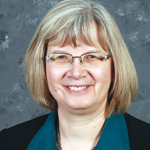
Freed
Her program provides 44 schools across South Dakota and North Dakota with telehealth medical care for students. A few of those schools also have signed on for a new behavioral health program in which licensed social workers offer therapy. For those schools that haven't, assessing and addressing mental health issues falls to nurses who are already remotely offering primary care services. Those services include assessing and treating students with common illnesses like colds and strep and monitoring students with chronic conditions such as diabetes.
Despite the heavy demands on school nurses, Freed and other school-based workers say assessing students for signs of COVID-19 and referring them for appropriate care can be added to the mix if the right protocols are in place. Among those protocols are setting up methods for students with symptoms that may indicate coronavirus to come and go from the nurse's office or school clinic without interacting with other students and educating parents on how to quarantine students who do have, or might have, the virus. Freed says testing of students for the virus is not being done in schools in North or South Dakota.
Home-based school health
In Baton Rouge, to match the schools' shift to virtual-only classes for at least the start of the year, the seven school-based clinics that are part of the Health Centers in Schools program are offering their services remotely, too. Students can have telehealth appointments with the same providers they would normally see in-person at the clinics.
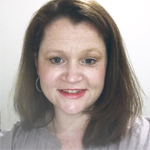
Rider
In anticipation of students' eventual return to campus, Tammy Rider, a registered nurse and manager of the clinics, and her staff spent some of their summer break creating signs to encourage social distancing, handwashing and wearing masks.
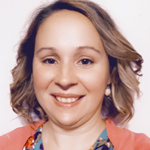
Duvic
Cheree Duvic, a registered nurse who oversees the nursing component of the Health Centers in Schools program, was part of a district task force that looked at how to best put in place contagion safeguards. One of the measures that she and Bolton, who was also on the task force, successfully lobbied for was requiring face masks even for the district's youngest students.
Duvic is pleased that the district took the recommendations of medical providers like her to heart as well as the concerns of other stakeholders like the parents of children with chronic illnesses who might be especially susceptible to COVID-19 and at risk for a severe outcome.
Both Duvic and Rider say understanding of the virus' spread is a vital factor in containing it. Like other school-based health workers, they expect that educating students and school staff on the need for and value of the precautions will be part of their jobs once in-person classes are back in session.
"We're ready. We want to see kids," Rider says. "We just all have to be mindful of those guidelines."